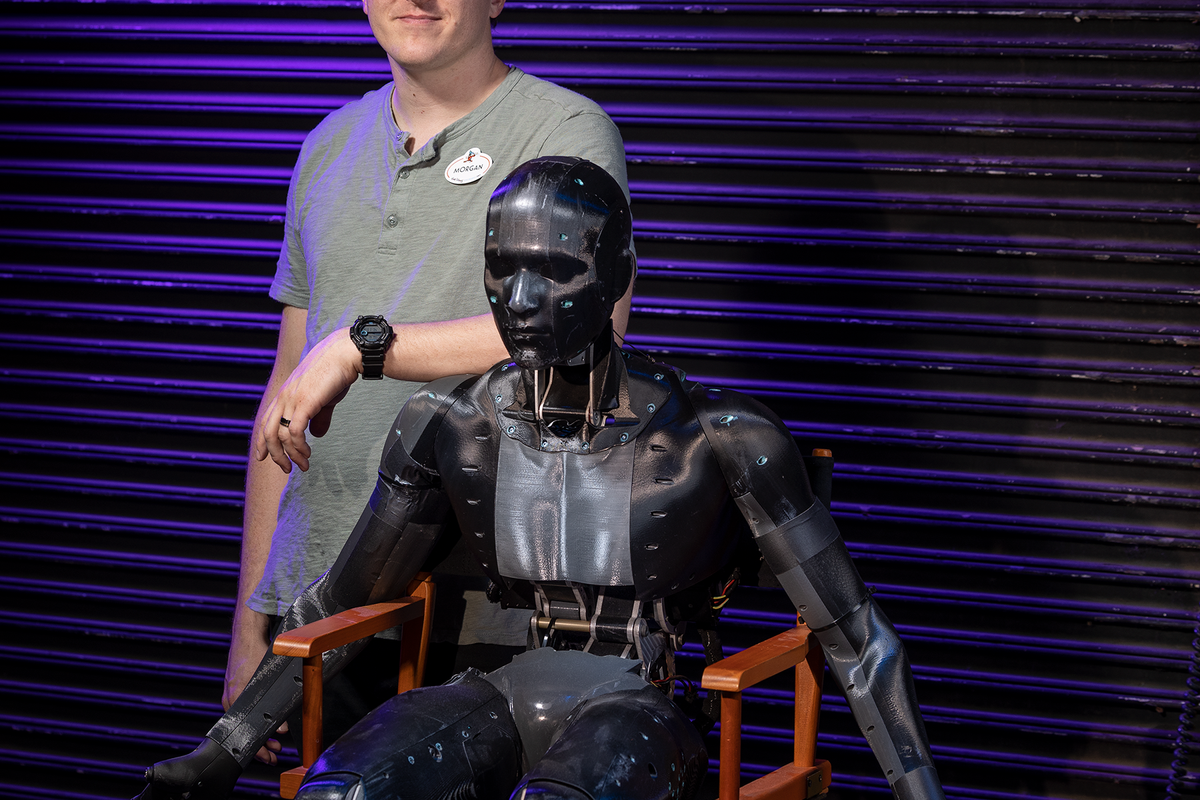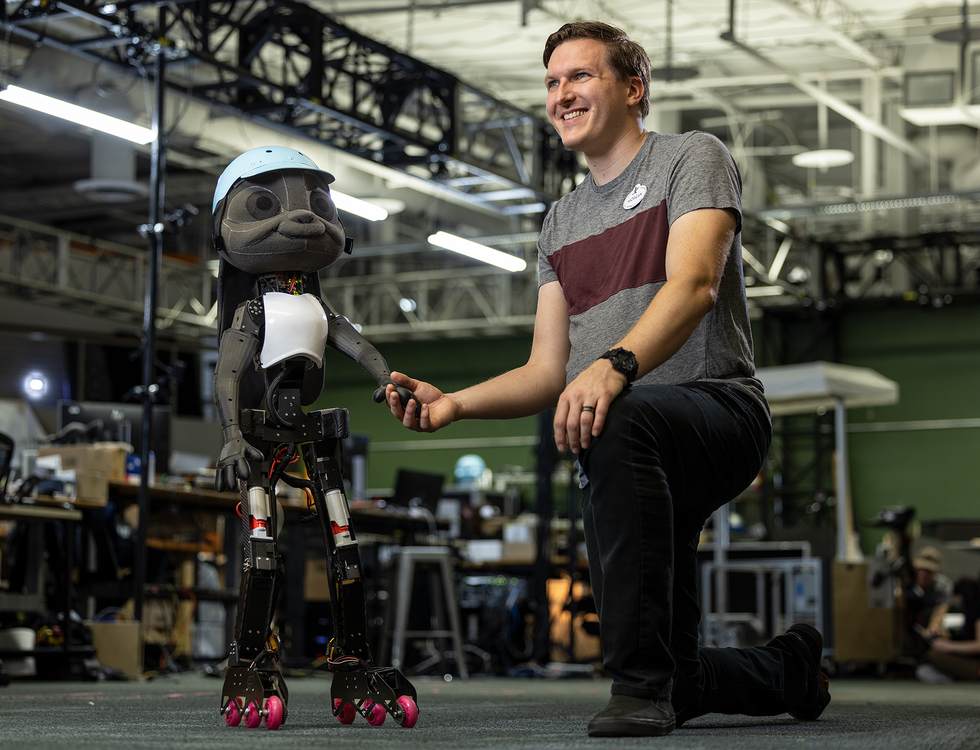Imagineer Morgan Pope Uses Electromagnetism to Spark Emotions

Most people probably think of robots as cold and calculating, but for Morgan Pope they can be a tool for generating emotions.
As a research scientist at Disney Research in Glendale, Calif., Pope designs robots for the entertainment giant's theme parks. But working as an Imagineer, as Disney's researchers are known, requires both in-depth knowledge of the latest technologies and an instinctive sense of magic."
Morgan PopeEmployer:
Disney Research, Glendale, Calif.
Title:
Imagineer
Education:
Bachelor's degree in engineering, Harvard; master's and Ph.D. degrees in mechanical engineering, Stanford
We have a very different mission compared to conventional roboticists," he says. We're trying to use electromagnetism to create emotions."
Robots have a long history at Disney. Since 1965, an animatronic of U.S. president Abraham Lincoln has been a fixture at Disneyland in Anaheim, Calif. But until recently, most of the robots on display have been firmly bolted to the floor, Pope says, and that has limited the stories they can tell.
Pope takes advantage of recent breakthroughs in robotics to create robots that can jump, flip, and tumble. He helped build the mechanical superhero Spider-Man, a stunt-double animatronic, or stuntronic, that makes death-defying leaps off buildings and over the heads of audiences at Disneyland's Avengers Campus. Today Pope is busy designing a rollerblading cartoon character whose clumsiness is designed to tug at your heartstrings.
We have all these amazing characters that do highly dynamic, engaging, fun things," he says. If we can bring these characters to life in ways that currently aren't possible, that can give people powerful emotional experiences."
A specialty in robot mobilityGrowing up, Pope was a bookworm. He loved science fiction and popular science magazines and gravitated toward topics like astronomy and quantum mechanics. In college, he discovered his passion for building things. He enrolled in engineering at Harvard, and during the summer before his senior year, he secured an internship at the university's Microrobotics Laboratory.
That experience stuck with him, and after graduating in 2011 Pope decided to pursue a master's degree in mechanical engineering at Stanford. He earned his master's in 2013 and then continued at Stanford, earning a Ph.D. in the same field in 2016. At the university's Biomimetics and Dexterous Manipulation Laboratory, he specialized in robot mobility. He led the design of the Stanford Climbing and Aerial Maneuvering Platform (SCAMP), a small robot that could fly, land on walls, and then climb them.
He had nearly finished his Ph.D. when he met with a friend who had worked at Disney Research in Pittsburgh. When Pope heard about the Imagineers and what they do, it immediately struck him as a great way to apply his skills. Entertainment applications for robotics sounded like a lot of fun, he says, and it was also a relatively unexplored field and therefore ripe for new innovations. That same year, Pope secured a job as a postdoctoral research associate at Disney.
If we can bring these characters to life in ways that currently aren't possible, that can give people powerful emotional experiences."
Three years later he became a full-time research scientist there, which took some adjustment. As an academic researcher, he spent a lot of time scrounging around for funding, Pope says, and when grants came through, the projects could take years to complete. The output was also primarily intellectual-you had to prove the basic idea worked, write a research paper, and move on.".
Grant writing is less of a concern for a Disney Imagineer, Pope says, but there is more pressure to deliver results quickly. Also, the kinds of problems Imagineers must solve are different from those of most roboticists. The robots are deployed in amusement parks, often in close proximity to guests, so they are held to much higher safety standards than is usual for most robots. There's also the pressure to ensure that the robots perform reliably and predictably for multiple shows a day. And, while conventional robotics is typically focused on completing a specific task, Pope says his goal is to bring characters to life. That means concentrating on the way the robots look, move, and behave as well as the specific actions they take.
It's not what it does, it's how it does it," he explains. It has to do it in a way that makes you feel like this is a real character, a real, live being."
Bringing Spider-Man to lifeLifelike action was crucial for the first project that Pope worked on at Disney. The goal was to create a robotic stunt double capable of performing complex aerial acrobatics for the Amazing Spider-Man show at Disneyland, which launched in 2021. The show features human performers, but one of the stunts involves Spider-Man backflipping 20 meters into the air, which is too dangerous for even the most skilled acrobat.
To convince the audience they were really watching Spider-Man, the researchers had to create a seamless transition between the acrobat and the robot, Pope says. His role was to work out the complex physics that would generate various somersaulting stunts while the robot was in midair. It was super rewarding to play around with one of the greatest superhero characters of all time," he says.
 Morgan Pope shows off Disney's new Indestructible robot, which can rollerblade, somersault, and perform other feats. Walt Disney Imagineering
Morgan Pope shows off Disney's new Indestructible robot, which can rollerblade, somersault, and perform other feats. Walt Disney Imagineering
Projects aren't always so clear-cut, he admits, and they involve a lot of experimentation. In the early phases, small teams knock out quick and simple prototypes until they hit on something that works.
You build something and then step back and think, What about this is making me feel something, what about it is connecting with me?'" Pope says.
The project he's currently working on involves a lot of this kind of exploration. For example, his team wanted to create robots that run, but the researchers quickly realized that the machines would fall down a lot. So they built a robot that could tolerate a tumble and get up again. In the end, they found that watching the robot pick itself up was what generated the most compelling emotional response.
You relate to the robot struggling, because we've all been flat on our backs and had to get up," he observes.
The team eventually scrapped the running concept and instead put its robot on a pair of Rollerblades. Many people know the awkwardness of trying to skate for the first time, and that makes the robot's clumsiness all the more relatable. When the researchers debuted a prototype at this year's South by Southwest in Austin, Texas, the audience's warm reaction made it clear that they'd made an immediate emotional connection, Pope recalls.
A job for a generalistBut building robots for Disney is about more than just intuition and emotional intelligence. It also requires skills in electronics, mechanical design, and programming.
You need to understand how different systems work, so if you need to dive into any of them, you can go deep and also pull them all together," Pope says.
That's why his team is always on the lookout for generalists. One of the two most important tips he gives to students, he says, is to familiarize themselves with as many disciplines as possible.
His other suggestion is to build something. It's the best way to figure out the kind of engineering that excites you the most, he adds. And learning to create stuff just for the joy of it is the surest path to a great career.
Try to build things that make you happy," Pope says. Chase the things that bring you joy. Chase the things that are delightful."